IN THIS ISSUE
- On high alert for bird illness
- Fins, fur and feathers in Paradise
- Mississippi kites in the backyard
 DNR gopher tortoise crew scopes a burrow at Ceylon WMA (Mac Stone)
By RICK LAVENDER
About this time every year, I start helping DNR’s Wildlife Conservation Section compile its annual report.
Now, annual reports aren’t known for their captivating reading. But, while I am biased, this one is intriguing. You might even call it revealing.
One thing it reveals is the work being done across our state to understand, restore and protect rare animals and plants and the places they need.
The report also shows how DNR wildlife plates – namely the eagle, monarch butterfly and older hummingbird tags – help make this possible.
How so?
When you buy or renew one of these plates, most of the extra $25 you pay for a specialty plate goes to the Georgia Nongame Wildlife Conservation Fund. Wildlife plate sales and renewals make up a third or more of the fund's revenue each year.
In turn, the nongame fund is critical to the Wildlife Conservation Section. Charged with conserving animals not hunted or fished for and rare plants, this part of DNR depends on fundraising. Less than 5 percent of its budget comes from the state.
As one of the section's primary fundraisers, that means DNR wildlife plates make conservation happen, whether it’s ensuring southeastern American kestrels have adequate places to nest or hellbenders have clear mountain streams to thrive in.
You could say these tags give wildlife a chance.
And you’d be right.
 Learn more about DNR wildlife plates and the conservation effort they support. Rick Lavender works in communications with the agency.
Top
 Fledgling grackle with crusty eyelids (left); a healthy adult blue jay (Leslie Frattaroli/NPS; Todd Schneider/DNR)
A mysterious illness that is killing backyard birds across the Mid-Atlantic and in parts of the Southeast has not been documented in Georgia yet. But DNR is on the lookout. And you can help.
First, some background. Since late May, sick and dying birds with symptoms including swelling and crusty discharge around the eyes and neurological issues such as tremors and lack of balance have been found from New Jersey and Pennsylvania to Kentucky and Virginia.
Most of the affected birds documented have been fledgling blue jays, American robins, common grackles and European starlings. However, other species of songbirds have been reported.
Wildlife disease labs testing the birds have ruled out salmonella bacteria, several families of viruses and Trichomonas parasites. But the disease and its cause are still unknown.
No issues have been reported with human health or pets, livestock or poultry. This issue is not connected to the salmonella outbreaks and other disease flare-ups associated with the winter finch irruption that swarmed Georgia feeders with purple finches and pine siskins this spring.
Ailing backyard birds reported to DNR usually either involve salmonella (bacterial), aspergillosis (fungal), avian pox (viral) or mycoplasmal conjunctivitis (bacterial). Trichomoniasis, a protozoan parasite, is also a potential problem. These diseases and their spread have been associated with birds at feeders.
Characteristic symptoms of the latest outbreak can include swollen/crusty patches over eyes (sometimes with oozing discharge), tremors or seizures and a lack of balance, partial paralysis or similar neurological conditions. Affected birds also are often lethargic.
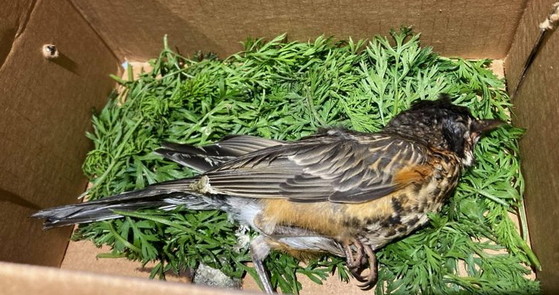 Fledgling American robin that died of the illness in Pennsylvania (Tamarack Wildlife Center)
WHAT YOU CAN DO
People finding sick or dead birds in Georgia with these symptoms are encouraged to contact DNR wildlife biologist Todd Schneider (478-994-1438; todd.schneider@dnr.ga.gov).
At this point DNR is not recommending taking bird feeders down. If the disease is confirmed in Georgia, DNR will provide further guidance as needed.
The agency continues to strongly recommend that people regularly clean bird feeders and bird baths and maintain feeding areas.
- Clean feeders weekly using a 10-percent bleach solution (one part bleach to nine parts water). Then rinse the feeders thoroughly and let them air dry. Wear protective gloves while cleaning feeders, feeding areas and bird baths, and wash carefully afterward.
- Rake up bird seed, hulls and bird droppings beneath feeders two or more times a week. It is especially important that wet seed and hulls are promptly removed. Discard them in the trash.
- Empty and clean bird baths every two days when bird visitation is heavy.
- If you have multiple feeders, space them out to reduce gatherings of birds.
If you find sick or dead wild birds at feeders or in your yard:
- Avoid handling them unless necessary. If you do handle them, avoid direct contact by wearing disposable plastic/latex gloves, then wash thoroughly.
- Keep pets (including pet birds) away from sick or dead wild birds.
- Dispose of dead birds in a sealable plastic bag placed in a secured outdoor trash bin or bury them deeply. This will help prevent disease transmission to other birds and wildlife.
- Learn more about sick, injured or orphaned wildlife.
Top
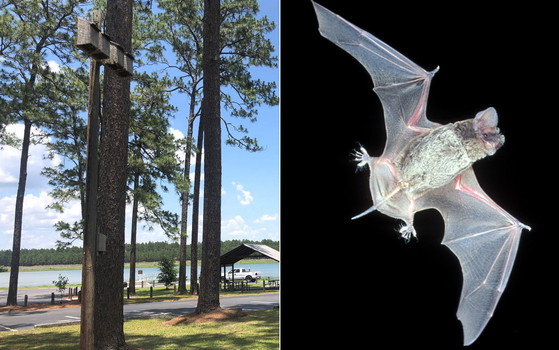 Well-used Paradise bat house; right, Brazilian free-tailed bat in flight (Katrina Morris/DNR; J. Scott Altenbach)
Paradise Public Fishing Area has long been prized by anglers. Just ask Tifton’s David Haire, who landed and released this 9-pound largemouth at one of Paradise’s 60-plus lakes and ponds a few weeks ago.
But the south Georgia PFA also has wild features that involve fur and even feathers.
One that’s easy to overlook is the large bat box near the Paradise office and picnic area on Lake Patrick. Inside the box are, well, bats: 200 or more recently, according to assistant PFA manager Jesse Boles.
“A lot of people just don’t know the bats are there,” Boles said.
Visitors who walk close can hear the bats during the day. And those who are there at sunset can watch Brazilian free-tailed bats – potentially lots of them – flying out.
Katrina Morris, a senior wildlife biologist who leads DNR’s work with bats, is often asked where to see bats in Georgia. She has started pointing them to Paradise.
“We don’t have a lot of bat houses or any kind of bat roosts that are easy to access by the public and consistently have bats for most of the year,” Morris said. “But if temperatures are above the 50s and it’s good weather, you have a chance of seeing possibly hundreds of bats emerging from this house.”
In addition to bats, Paradise has birds. It’s a hotspot on eBird, with 200 species seen, from bald eagles and ospreys to bobwhites, yellow-throated warblers and a changing winter lineup of ducks. There are reptiles – look for gopher tortoise burrows along the nature trail – and big mammals such as deer and beavers, as well.
Although the PFA's address is Enigma, the reason why Paradise holds such promise for spotting wildlife is no puzzle. The 1,351 acres sport a variety of habitats, including 525 acres of water.
“I’ve lived all over the state,” Boles said, “but you can really see just about any species here.”
WHEN YOU GO
- Paradise PFA is open 24-7. Too see bats, arrive a half-hour before sunset. (Consider calling ahead to make sure the house is occupied, 229-533-4792.)
- The Brazilian, or Mexican, free-tailed bats will begin emerging at about sunset, usually starting with a few then becoming a quick stream of bats flying out.
- A fishing or hunting license or a lands pass is required to visit the PFA (a fishing license is needed to fish). The best deal for buyers and conservation is a fishing or hunting license. Each sale returns to Georgia wildlife the fee plus up to $45 in federal excise taxes paid by hunters and anglers.
- Other public fishing areas are also rich in opportunities to not only fish but see other wildlife. Some offer recreation including archery and camping.
- Learn more about Georgia's bats.
Top
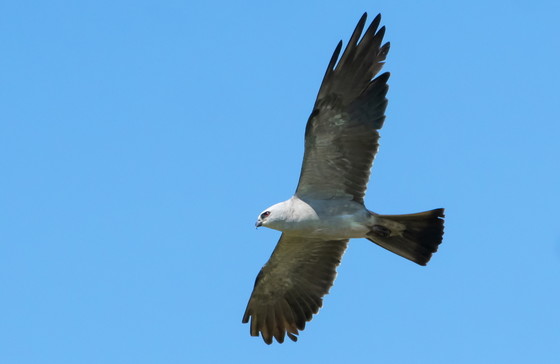 By TERRY W. JOHNSON
If you were asked to list your backyard birds, that list would undoubtedly include brown thrasher, northern mockingbird, Carolina wren, northern cardinal, ruby-throated hummingbird and a host of other birds you regularly see in your yard.
Remarkably, in recent years some Georgians have been able to include Mississippi kites.
Mississippi kites are one of the bird world’s most accomplished fliers. When airborne, these slender birds use their long, falcon-like wings and square tails to perform loops, circles and glides so spectacular they would make a barnstorming stunt plane pilot proud.
Those of us who are most likely to see Mississippi kites during spring and summer live in the southern half of Georgia. But over the past several decades they have begun nesting on golf courses, in parks and even in suburban neighborhoods and urban areas, including in Augusta, Macon, Dublin, Waycross, Savannah … and, though rarer, as far north as Athens …
Read the rest of Terry’s column for insights into these flying acrobats.
Terry W. Johnson is a retired DNR program manager and executive director of TERN, the Wildlife Conservation Section’s friends group. Check out past columns, his Backyard Wildlife Connection blog and his book “A Journey of Discovery: Monroe County Outdoors.” His columns are also featured at DNR’s blog, under the Conservation tab. Permission is required to reprint Terry’s columns.
Top
News flash: Recovering America's Wildlife Act is in the U.S. Senate. Sens. Martin Heinrich, a New Mexico Democrat, and Republican Roy Blunt of Missouri introduced S. 2372 this week as a bipartisan, $1.4-billion answer to conserving the one-third of U.S. wildlife species at risk of becoming endangered or threatened. The Senate version of the bill, which is already in the House as H.R. 2773, will dedicate vital funding without raising taxes for states and tribes to protect and restore nearly 12,000 animal and plant species, including 639 in Georgia. As part of a $3.3 billion economic impact, the legislation would generate an estimated 33,000 jobs per year, says the Alliance for America's Fish and Wildlife. Georgia lawmakers unanimously approved a resolution urging Congress to pass Recovering America’s Wildlife Act.
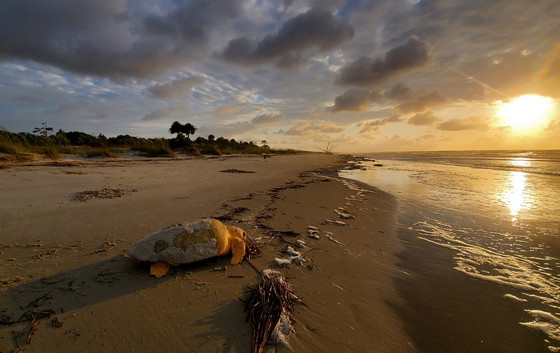 An adult loggerhead returns to the ocean at dawn after nesting on Ossabaw. (Breanna Sorg/DNR)
Sea turtle nesting season in Georgia has passed the halfway mark and hatchlings are emerging (Sea Island reported the first). With nesting winding down on Ossabaw and other barrier islands, more than 2,100 loggerhead nests have been documented, fewer than last year’s 2,786 but far more than the 32-year average of 1,483 nests. Follow the Georgia Sea Turtle Cooperative on Facebook.
The deadline to register for this year’s Youth Birding Competition is Aug. 13. The DNR bird-a-thon, rescheduled from April to Sept. 24-25, is a free statewide event for all and includes a fun awards banquet at Indian Springs State Park in Flovilla.
Four budding bird artists have been named T-shirt Art Contest winners in the Youth Birding Competition. The loggerhead shrike drawn by 11th-grader Owen Li of SKA Academy of Art and Design in Duluth led the 155 entries and will be featured on shirts provided teams at the competition banquet. See the blue-ribbon artwork.
Top
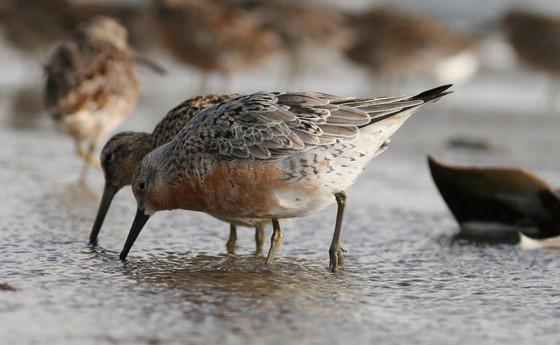 Red knots (Brad Winn/DNR)
With the shrinking population of red knots making news, a DNR project monitoring these long-distance flyers that migrate through Georgia did not find larger-than-average numbers this spring. The apparent sharp decline in red knots possibly occurred in recent years: Staff are working to help determine why. Stay up to date on shorebird conservation in the Americas.
Flatheads are still the Satilla River’s most abundant catfish but DNR sampling did find encouraging numbers of native catfish. Also per the annual checks, the Ogeechee River is apparently flathead-free, yet the Savannah, although it has a mix of species, is dominated by the invasive flatheads in some sections.
The question is whether the two Medionidus mussels collected in the Conasauga River as part of a DNR survey are endangered Coosa or federally threatened Alabama moccasinshells. Whatever the genetic samples show, this would be the most downstream find of either rare mussel in the mainstem Conasauga since the early 2000s.
Top
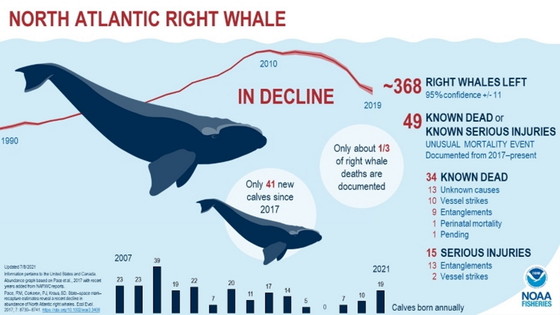 As Canada tries to free two North Atlantic right whales entangled in commercial fishing gear, this graphic sums up the dire situation these endangered whales are in. And here's a story map of NOAA's “unusual mortality event” involving right whales.
Surveys of 21 relict trillium sites in Georgia this spring rated many of the stands in fair shape, some with more than 1,000 stems. According to DNR botanist Gemma Milly, almost half of the endangered plant’s 51 known sites in the state rank as excellent to good, while a fifth haven’t been surveyed in 20 or more years.
How is the restoration of longleaf pine and related habitats going? Quite well, America’s Longleaf Restoration Initiative says in its 2020 report, which lays out “1.9 million acres of accomplishments.”
Top
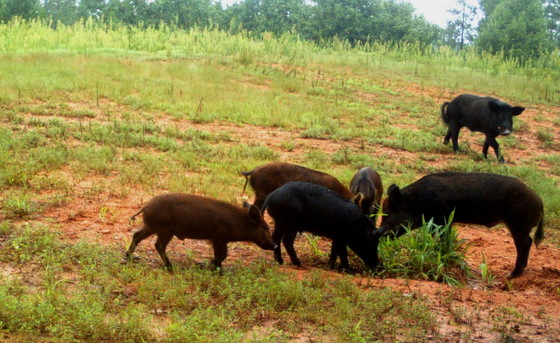 A game cam image of feral hogs doing what they do best: rooting.
Add greenhouse gases to the environmental impact of feral hogs. A new study estimates wild hogs uproot about 14,000 square miles a year, a disturbance that releases 5.4 million tons of carbon dioxide from the soil, or about the same as 1.1 million cars. One researcher likened them to “mini tractors ploughing the soil.”
Names in the news: Known for her philanthropy involving the arts, conservation, health care and education, Celestia “Lessie” Smithgall died at age 110 last month. Smithgall’s home will now be added to the 186 acres she donated to Atlanta Botanical Garden’s Smithgall Woodland Legacy in Gainesville. In 1994, her late husband Charles Smithgall Jr. sold their 5,600-acre estate near Helen to the state for half its value, leading to the creation of Smithgall Woods State Park and Regional Education Center. Charlie Elliott Wildlife Center’s Berkeley Boone led a recent training program for DNR State Parks naturalists and interpreters on the husbandry and handling of wildlife. The July newsletter of the American Fisheries Society’s Georgia Chapter includes articles from DNR’s Ani Escobar, Neely Keeton and Matthew Rowe. Noted naturalist Jim Fowler, 74, of Greenville, S.C., died June 25 while researching orchids at a North Carolina state park.
WHAT YOU MISSED ...
In the previous Georgia Wild:
- Grant boosts ability to save plants
- Latest on bald eagle nesting in Georgia
- How downies dine when not at your feeder
Top
"Sea turtle nesting numbers indicate continued recovery," The Brunswick News
"Study: smaller sea turtles nesting on Fla. beaches," University of Central Florida. Journal article.
"Federal grant will grow work to save state plants," The Atlanta Journal-Constitution
(+video) "The impact of invasive lizards (tegus) in Georgia," RFD-TV
"Two right whales entangled off New Brunswick," Canadian Broadcasting Corp. Related: "Entanglement badly injures young whale," WSHU-FM (91.1, Fairfield, Conn.)
"Living shorelines research aids fight against sea-level rise," The Current
"Ticks suck: How to identify them and avoid bites," NPR
(+video) "Georgia family finds 18 snakes in bedroom," WSB-TV (Ch. 2, Atlanta). Related: "Snakes in the house; how to get them out," The Augusta Chronicle.
"Bald eagles get more urban as numbers rise in Chatham," Savannah Morning News
"T-shirt art winners announced in Youth Birding Competition," AllonGeorgia. Also: Yahoo! News, Jackson Progress-Argus and others.
"Annual count spots more butterflies, fewer species," Monroe County Reporter
"Atlanta woman wakes to find African serval on bed," United Press International
"Florida enacts sweeping law to protect wildlife corridors," National Geographic. Related: "Legislation to protect corridors passes U.S. House," Wildlands Network
"Neighbors concerned after string of bear sightings," WSB-FM (95.5, Atlanta)
"Builders eye mass timber for construction, conservation," U.S. Fish and Wildlife Service. Also: Partnership to protect eastern black rail.
"How cities can help solve biodiversity crisis," Yale Environment 360
Top
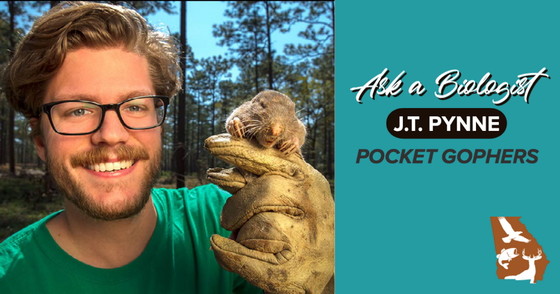 "Ask a Biologist: J.T. Pynne on Pocket Gophers," DNR Instagram story highlights
2021 Audubon video winner: red-tailed hawk hovering (Bill Bryant), Audubon (article). Honorable mention: great gray owl in snow (Brent Cizek).
"Talking Nature Tuesday: How Wildlife Keep Cool," DNR
"Beautiful Color of Rare Birds in Three Dimensions," Scientific American (article)
"Fawn save at Rich Mountain WMA," DNR
Great white feeding on right whale carcass off S.C., Outcast Sport Fishing
"Home Sweet Home: a Place for Birds and People" (animated), Atlantic Flyway Shorebird Initiative
Top
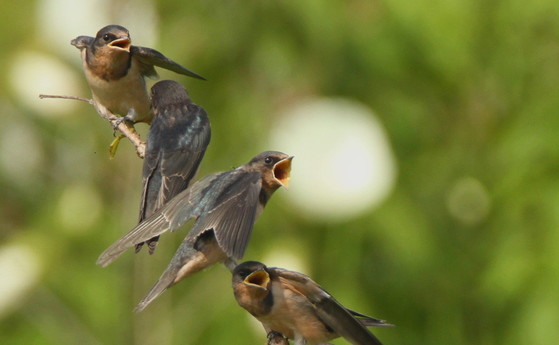 Fledgling barn swallows at Dyar Pasture (Josiah Lavender/DNR)
Young barn swallows line a limb at Dyar Pasture Recreation Area, begging for their parents to feed them. The 60-acre wetland just off the Oconee River on Oconee National Forest in Greene County is described as both “a bird sanctuary and a birder’s paradise.” Latest sightings on eBird.
CREDITS
Masthead: Loggerhead shrike, Youth Birding Competition T-shirt Art grand champion, by Owen Li
Top
|